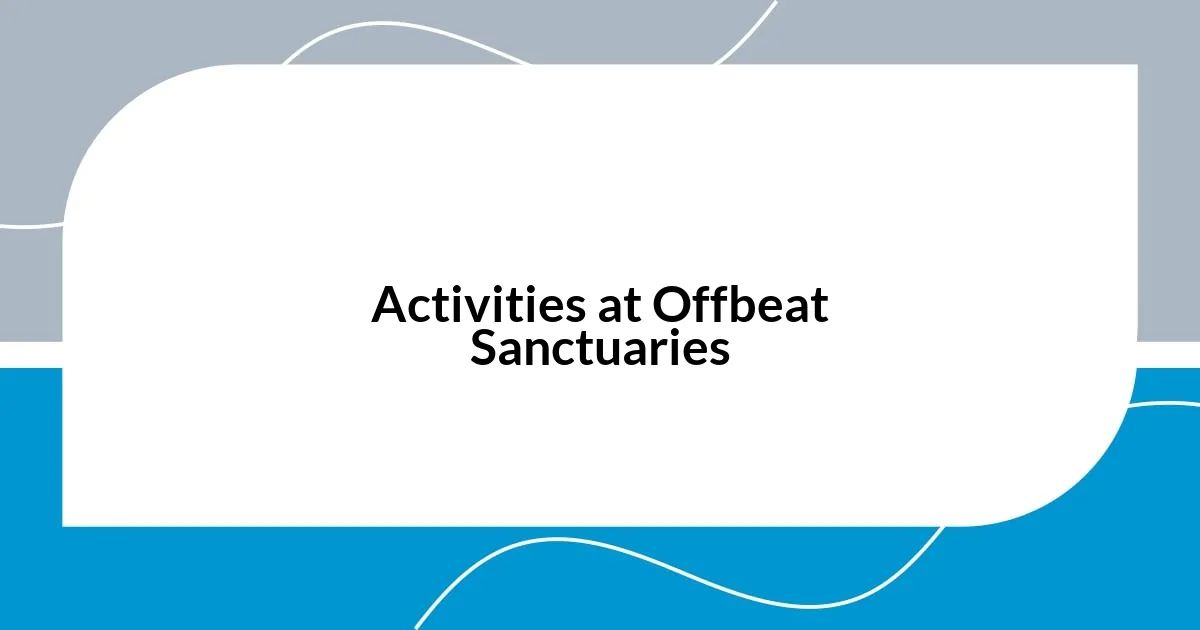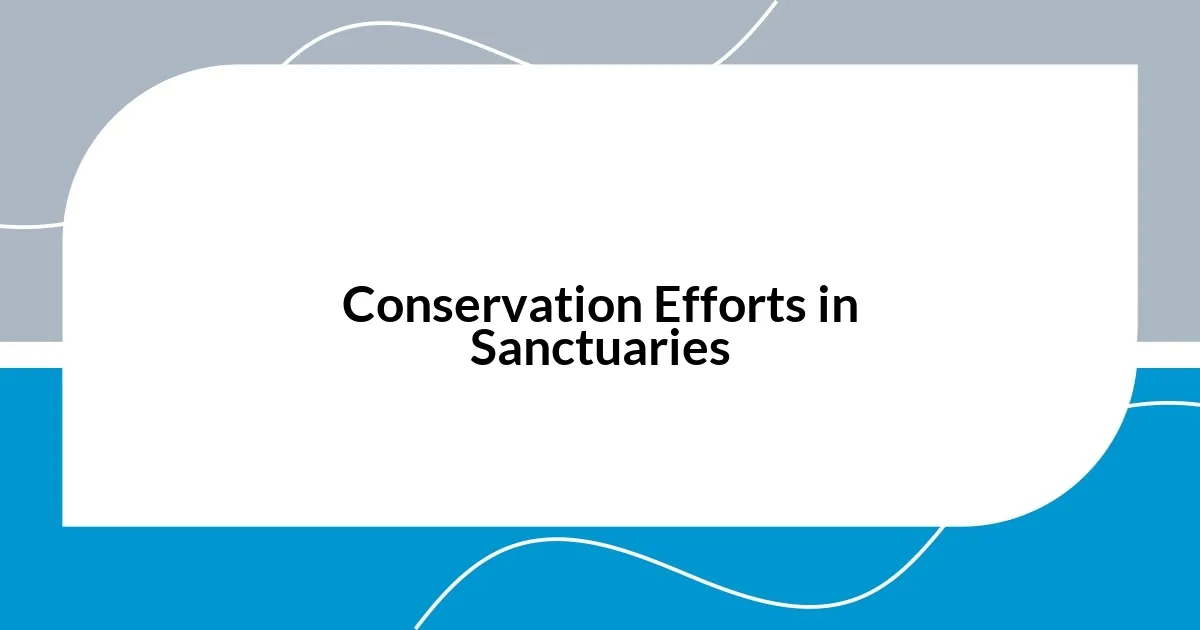Key takeaways:
- Offbeat animal sanctuaries prioritize rehabilitation and foster connections between humans and animals, focusing on compassion and healing.
- Choosing a sanctuary involves aligning with its mission, ethical practices, and opportunities for volunteer engagement to enrich the visitor experience.
- Participation in engaging activities, such as shadowing caretakers or wildlife workshops, can deepen understanding and foster memorable experiences.
- Conservation efforts in sanctuaries are vital, emphasizing species rehabilitation and educating the public on the interconnectedness of animal welfare and conservation.

Introduction to Offbeat Sanctuaries
Offbeat animal sanctuaries captivate me for their unique missions and the diverse creatures they protect. Unlike traditional zoos, these sanctuaries often focus on rehabilitation and providing safe havens for animals that have been neglected or abused. Have you ever wondered what life is like for a rescued animal that finds its second chance in an unexpected place?
During my travels, I stumbled upon a sanctuary tucked away in the hills, dedicated to exotic birds. The volunteers were as colorful as the parrots they cared for, sharing heartfelt stories about each bird’s journey. It made me realize that every sanctuary has a story, intertwined with the fate of its inhabitants—a reflection of resilience and hope.
These spaces not only shelter animals but also foster incredible connections between humans and creatures often overlooked. When you step into an offbeat sanctuary, you’re not just an observer; you become part of a community dedicated to compassion and healing. Isn’t that a beautiful thought?

Choosing Unique Animal Sanctuaries
Choosing a unique animal sanctuary involves more than just picking a destination—it’s about aligning with the sanctuary’s mission and values. I once visited a sanctuary focused on reptiles and amphibians, where I was welcomed by a warm, knowledgeable guide who had a genuine passion for these often-misunderstood creatures. That kind of enthusiasm is infectious; it deepens your connection to the animals and enhances your experience.
When selecting a sanctuary, consider the following factors:
– Mission Alignment: Does the sanctuary focus on rehabilitation, education, or conservation?
– Ethical Practices: Are the animals kept in naturalistic environments that prioritize their well-being?
– Volunteer Opportunities: Can you participate, and how does that involvement contribute to the sanctuary’s goals?
– Community Engagement: Does the sanctuary foster strong connections between visitors and staff?
– Personal Anecdotes: Sharing stories from visitors enhances the understanding of each animal’s journey.
By reflecting on these elements, you’ll ensure that your visit enriches not only your understanding but also contributes positively to the lives of the animals you encounter.

Planning Your Sanctuary Visits
When planning your sanctuary visits, timing and research are key. I remember visiting a lesser-known sanctuary during feeding time, and it was magical to witness the animals’ enthusiasm. Check their schedules online; some sanctuaries offer special events or guided tours that provide deeper insights into their work.
Staying nearby can enhance your experience, allowing you more time to explore and understand the sanctuary’s environment. I once extended my trip to a sanctuary nestled in a scenic area, and it gave me the chance to participate in evening activities, like helping with enrichment sessions. Those moments of engagement created lasting memories that made my visit unforgettable.
Don’t underestimate the importance of appropriate attire and preparation. I’ve learned the hard way that sturdy shoes and sunscreen can make a huge difference. Animal sanctuaries often involve walking and being outdoors, so being comfortable ensures you can focus on the incredible experiences around you.
| Considerations | Personal Experience |
|---|---|
| Timing of Visit | Witnessed feeding times that lit up the sanctuary with joy. |
| Location & Accommodation | Staying close allowed me afternoon and evening exploration. |
| Preparation | Wearing proper shoes made my day much easier and enjoyable. |

Activities at Offbeat Sanctuaries
I’ve discovered that activities at offbeat sanctuaries can be so diverse and engaging. For instance, at one sanctuary, I joined a shadowing program that allowed me to spend a day with the caretakers. It felt incredible to see how they fed the animals and created enriching environments for them—did you know that even simple changes in their habitat can significantly affect their behavior?
Another memorable experience was participating in a wildlife photography workshop hosted at a sanctuary focused on native birds. The expert shared tips on patience and positioning, which resonated with me. Capturing those moments felt like a privilege, and each click of the camera helped me appreciate the beauty of these feathered creatures.
Volunteering can be a deeply rewarding aspect of visiting offbeat sanctuaries. I once spent a weekend helping with landscaping—who would’ve thought pulling weeds could feel so fulfilling? Knowing that my efforts contributed to a healthier environment for the animals was genuinely satisfying. It’s amazing how hands-on activities can provide a deeper connection to the mission of a sanctuary.

Finding Volunteer Opportunities
Finding volunteer opportunities at animal sanctuaries can sometimes feel like searching for buried treasure, but the rewards are truly worth the effort. I remember feeling a rush of excitement when I stumbled upon a small, indie sanctuary via social media. Their call for volunteers resonated with me immediately, and it made all the difference to connect with the passionate team there. Have you ever experienced that thrill of discovering a hidden gem?
Networking plays a crucial role in uncovering these opportunities. Engaging with fellow animal lovers in local forums or social media groups can open doors to sanctuaries that may not be widely publicized. When I reached out to a group of volunteers online, they generously shared their experiences and even provided contacts for lesser-known sanctuaries. It felt like being part of an exclusive club, all sharing a common love for animals.
Always check the sanctuary’s website or mailing list too. Many offer regular updates about volunteer needs and special events. I recall one sanctuary where I signed up for a weekend workshop—it turns out that was their busiest time, and my help was genuinely appreciated. Being proactive and staying informed can transform your adventure and create unforgettable connections within the animal care community.

Conservation Efforts in Sanctuaries
When visiting offbeat sanctuaries, I’ve seen firsthand how conservation efforts play a pivotal role in saving species. For example, one sanctuary I visited focused on rehabilitating injured wildlife and releasing them back into their natural habitats. It struck me deeply how each animal saved represented a tiny victory in the large fight against species decline. Have you ever felt the mix of joy and hope that comes from seeing a once-injured animal take flight again?
The passion of the caretakers is infectious and deeply inspiring. I remember a day spent with a group working on breeding programs for endangered species. Their commitment to maintaining genetic diversity and studying breeding behaviors reminded me of how crucial each individual animal is to the ecosystem. It raises a thought: what would our world look like if we didn’t prioritize these efforts?
Moreover, some sanctuaries engage in educational programs that promote awareness about conservation outside their walls. During a workshop, I listened to a captivating talk about local wildlife and its challenges. The knowledge shared highlighted the interconnectedness of our actions and animal welfare. It made me reflect on how even small changes in our daily lives can contribute to conservation efforts—have you considered how your choices impact the animals around you?

Personal Experiences and Reflections
I’ll never forget the moment I connected with a mischievous goat who seemed to have a personality that lit up the entire sanctuary. While I was cleaning her enclosure, she butted her head against my leg, demanding attention. It was in that playful interaction that I realized these animals are more than just inhabitants of a sanctuary; they each have their own stories and quirks, and it made me think about how often we overlook their individual needs in a world focused on efficiency. Don’t you ever wonder how much joy we can share simply by giving attention and love to those in need?
Reflecting on my volunteer experiences, I recall one particular day spent fostering young birds before their release. As I fed them, I felt a profound sense of purpose and connection. Watching them stretch their wings for the first time left me with a bittersweet feeling; I was filled with joy but also sadness knowing they were leaving my care. It really made me think about the cycles of life and how beautiful—and sometimes heartbreaking—those moments can be. Have you ever felt that mix of happiness and melancholy when nurturing something back to health?
Each sanctuary visit has taught me about resilience and hope, reminding me that every effort counts. Once, while interacting with a shy raccoon, I realized that patience can break barriers, both for animals and within ourselves. There’s something transformative about being present with these creatures, understanding their fears, and witnessing their gradual trust. It raised a profound question in me: how often do we apply that same patience in our everyday lives, with our relationships and challenges?